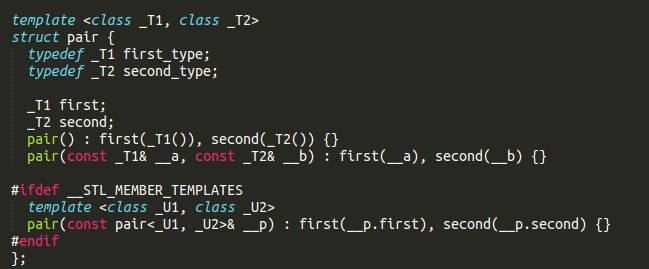STL 源码分析 # stl_pair #
STL 源码分析 # stl_pair #
pair是一种很简单也很常用的关联容器(associative container).
/*********************************************** Programmer : EOF Date : 2015.04.10 File : pair.cpp E-mail : [email protected] ***********************************************/ #include <iostream> #include <string> using namespace std; int main(int argc, char const *argv[]) { pair<int, int> int_pair(100, 200); pair<string, int> si_pair("hello world", 42); pair<string, string> ss_pair("jason", "leaster"); cout << int_pair.first << " " << int_pair.second << endl; cout << si_pair.first << " " << si_pair.second << endl; cout << ss_pair.first << " " << ss_pair.second << endl; return 0; }

很难得啊...pair数据类型的数据成员居然不是私有成员~
我们看看pair的实现:
这是我到目前为止在STL里面看到的最简单的数据抽象... ...
支持的各种比较运算符:
template <class _T1, class _T2>
inline bool operator==(const pair<_T1, _T2>& __x, const pair<_T1, _T2>& __y)
{
return __x.first == __y.first && __x.second == __y.second;
}
template <class _T1, class _T2>
inline bool operator<(const pair<_T1, _T2>& __x, const pair<_T1, _T2>& __y)
{
return __x.first < __y.first ||
(!(__y.first < __x.first) && __x.second < __y.second);
}
#ifdef __STL_FUNCTION_TMPL_PARTIAL_ORDER
template <class _T1, class _T2>
inline bool operator!=(const pair<_T1, _T2>& __x, const pair<_T1, _T2>& __y) {
return !(__x == __y);
}
template <class _T1, class _T2>
inline bool operator>(const pair<_T1, _T2>& __x, const pair<_T1, _T2>& __y) {
return __y < __x;
}
template <class _T1, class _T2>
inline bool operator<=(const pair<_T1, _T2>& __x, const pair<_T1, _T2>& __y) {
return !(__y < __x);
}
template <class _T1, class _T2>
inline bool operator>=(const pair<_T1, _T2>& __x, const pair<_T1, _T2>& __y) {
return !(__x < __y);
}
而make_pair函数其实本质上也就是调用了构造函数....


